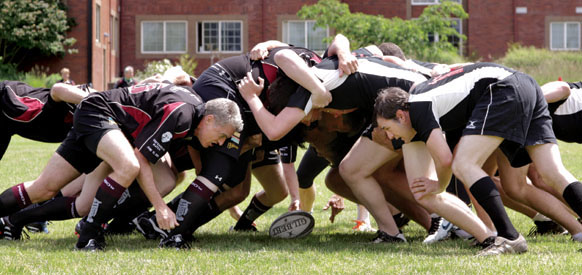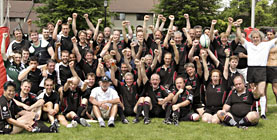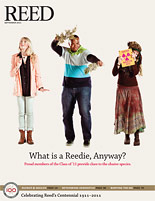
IRIS login | Reed College home Volume 90, No. 3: September 2011
Rucked and Mauled

Photos by Matt Giraud ’85
Clash of the ages at Reed rugby centennial match.
By Kilian Kerwin ’85
I was on the fence about attending Reunions this year. While the idea of going back for Reed’s centennial was appealing, I wasn’t sold. Then Benn Lewis ’85 made an offer I couldn’t refuse: “How about players of the ’80s challenge the rest of the calendar to a rugby match?”
Rugby. Of course.
Reed is an iconoclastic place and like all such places it creates its own icons. And nothing is more iconic than Reed rugby.
To those who’ve never played, it is hard to grasp the allure. A full-contact sport with no protective gear? How un-Reed. How downright insane. And yet, for those who play, the attraction is irresistible. Within the chaotic morass of individual achievement that is Reed, we ruggers are a feline herd. We work, play, and party together. The team is all.
A Facebook group sprang up, and suddenly ruggers who hadn’t set foot on campus in 30 years were booking flights from as far away as Calgary, New York, and London.
What was it about rugby that sparked this fervor? What compelled people to extract themselves from their manic modern lives, travel hundreds or thousands of miles, to incur certain injury?
Rugby is quintessentially Reed—quirky and outside the mainstream—yet simultaneously anti-Reed in that it requires teamwork, physical conditioning, and surrender to an arbitrary authority.
The origins of rugby at Reed are nebulous. According to John Hart ’77, the first squad included several refugees from the crew team, which bailed in 1973. Original cast members included Jim O’Neill ’76, Don Coppock ’77, Gordon Rickels ’77, Mike Gorby ’78, and Deane Little ’78. “The first year (1974–75) was largely self-taught, using a book,” says John. “There was an exchange student from Keele who gave us a lot of pointers. Our first game, in fall 1974, was against Eugene. Ouch.”
There were “no coaches or support or funds or general adult supervision,” says Mike. “But also, no rules or legacy or established ideas!”
When I arrived at Reed in 1981, the “no coaches or support or funds” was still in effect though there was definitely a rugby sub-culture on campus. I joined the squad my junior year and discovered that the rugby team played U of O, UW, OSU, and other state universities that dwarfed Reed’s tiny enrollment, as well as men’s teams from Portland, Salem, and Eugene. It was boys against men. Hard men, too: guys who worked in steel mills and factories while we went to Hum conference and Bio lab.
But against all odds, rugby flourished at Reed. The ’82–’83 team (including nine starters from the Centennial Match) went 8–1 and captured the Oregon B-side championship. In 1987, a group of Reed grads won the Eugene 10-a-side tournament. In 1989, a touring side flew to Portugal to play the Portuguese national U-19 sevens team, and won the Taça Laranja (Orange Cup) at the Lisboa Sevens, a prestigious international tournament. Reed women’s rugby was also represented in Portugal: Jean Field ’84, Donna Anderson ’88, Maria Chora Lewis ’88, Carol Schultze ’88, Marya Zlatnik ’88, Laura Masterson ’91, and Elena Zlatnik ’91 won the women’s division of the Coimbra Sevens.
Maybe there’s something about the game itself—putting your body on the line, depending on your teammates for protection and support—that forms a bond that withstands the test of time.
![]()
We held a pregame strategy session at the Horse Brass Pub the Thursday night of Centennial Reunions. Seats grew scarce and camaraderie swelled as old ruggers descended on what seemed like Olde Reed Central. Ditto the next afternoon at the Steele Street pitch, where our official practice session was disrupted every time another familiar face appeared.
The weather on centennial Saturday was perfect. The opposition, organized by Gerard Schneider ’00, graciously agreed to two 20-minute halves of a centennial match followed by two more friendly halves, so that everyone could get a run.
The shock and awe was palpable when our side—dubbed the 1980s First XV—took the pitch. Kit designed for the occasion by Matt Giraud ’85 was embroidered with logos from 1980s mainstays: Tom Peterson, Quality Pie, the Hotcake House, and, of course, Lutz Tavern. Each served as a totem from which we drew a hidden power, a shared boost—like an elixir of nostalgia-fueled energy.
And although our hair was grayer and our waistlines more imposing, we found ourselves (with respect to Dave Brubeck) all together again for the first time. William Cussans ’83 was awestruck: “It’s amazing . . . this is the exact same back line I played with 28 years ago.”
The match itself was basically over 40 versus under 40. Our oldest player was 55; their youngest still couldn’t legally buy beer. Olde Reed vs. New Reed or, more accurately, Older Reed vs. Newer Reed. They had vim and vigor on their side. We had determination. And maybe a little of that old mojo.
On the sidelines, family and friends who were skeptical (or appalled) at the proposition of a motley crew of ruggers reconvening to relive their glory days witnessed a hard, fair, and sporting match.
Cheering us on were ’80s ruggers Lynn Spitaleri ’82, Leigh Hancock ’84, Jess Dubey ’85, Cathy Ciarlo ’87, Corinna Wilborn ’87, Darci Rudzinski ’90, Sasha John ’91, Naomi Rubin DeVeaux ’92, and Martha Richards ’92. Our touch-judge was Barbara Bond ’84, captain of the U.S. National Team that won the Women’s Rugby World Cup in 1991.
When the final whistle blew, the score was 14–10 to the elders. Though we were drunk with victory, the “W” was superfluous. It was the event itself that was magic; we had carried the day before it even started.
Afterwards, Older Reed invited Newer Reed to an extravaganza at the home of Laura Masterson and Eric Contey ’83. Master Chefs George Wehn ’84 and Jon Wehn ’88 roasted two pigs donated by Bryne Anderson ’86 and libations were laid on by brewmaster Sebastian Pastore ’89 and wine deity William Fitch ’86.
As we gathered to reflect on our common love and respect, we paused to remember Milton Fischer ’87 and Michael Babic ’89, taken from us before their time. What we would have given to have those beloved men stand beside us one last time.
The truth is that we’ll probably never get this 1980s crew together again; even if we did, our competitive window is closing fast. In a way, we got lucky that the 100 years of Reed coincided with our sell-by date as players: old enough to impress onlookers that we’d play at all, young enough to have one last good match in us.
In any case, the centennial match was—without hyperbole—a once-in-a-lifetime event. To have missed it would have been to deny my own existence.
The 1980s First XV contributed $4,225 to the Annual Fund.



LATEST COMMENTS
steve-jobs-1976 I knew Steve Jobs when he was on the second floor of Quincy. (Fall...
Utnapishtim - 2 weeks ago
Prof. Mason Drukman [political science 1964–70] This is gold, pure gold. God bless, Prof. Drukman.
puredog - 1 month ago
virginia-davis-1965 Such a good friend & compatriot in the day of Satyricon...
czarchasm - 4 months ago
John Peara Baba 1990 John died of a broken heart from losing his mom and then his...
kodachrome - 7 months ago
Carol Sawyer 1962 Who wrote this obit? I'm writing something about Carol Sawyer...
MsLaurie Pepper - 8 months ago
William W. Wissman MAT 1969 ...and THREE sisters. Sabra, the oldest, Mary, the middle, and...
riclf - 10 months ago